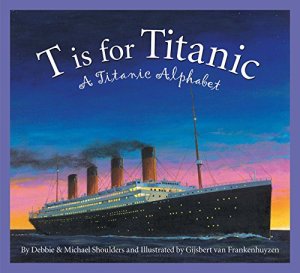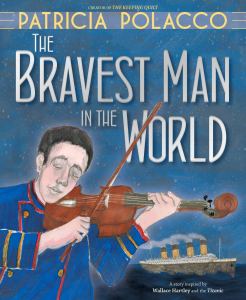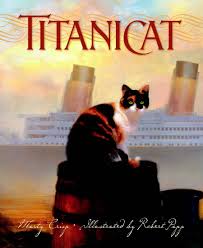Wallace Hartley is the man who played the violin as the Titanic sank. He was praised as the “bravest man in the world” because he was offered a space on a lifeboat, but instead stayed to calm the scared passengers by playing as the ship sank. The story is told by Jonathan Harker, a stowaway befriended by Hartley, to his grandson who doesn’t want to practice the piano.
Patricia Polacco, Simon and Schuster, ©2019, ISBN 978-1-4814-9461-8
Inquiry: Famous Disasters at Sea
It might make a good “rapid research” inquiry topic for students in pairs to find the basic when, where, why, how for the disasters. They need to also create ten interesting sentence facts about the disasters.
They could also pose questions themselves for all disasters: What are the most common causes of marine disasters? Were any changes to the “rules” of the sea made after the disaster? Why do we particularly remember these disasters? How many people died? How do we know these disasters occurred?
It helps if the students generate the questions themselves. At the end, create a chart with questions down one side and disasters across the top. With each question, have students chime in anything that found that would help to answer the question. This is genuine evidence-based research of the kind for which scholars get doctorates. Example of past famous disasters at sea are:

- The Mary Rose, 1545
- The Spanish Armada, 1588
- The Vasa (Swedish), 1628
- The Merchant Royal, 1641
- The Scilly Naval Disaster, 1707
- The Black Swan, 1804
- The Tek Sing, 1822 (China)
- The HMS Birkenhead, 1845
- The Titanic, 1912
- The Kiche Maru Typhoon, 1912 (Japan)
- The Great Lakes Storm, 1913
- The Lusitania, 1915
- The Halifax Explosion, 1917
- The Bismarck, 1941
- The Wilhelm Gustloff, 1945
- The Edmund Fitzgerald, 1975
- The Exxon Valdez, 1994
Other Picture Books About the Titanic
There seem to be innumerable books about the Titanic written with children in mind: pop-up books, colouring books, detective books, etc.

Titanicat (click for teaching ideas) is the story of a genuine survivor of Titanic who by a twist of fate did not get on the ship.
T is for Titanic is an ABC book for words from the Titanic. I have always had success with selecting a topic under study in Social Studies and having students working to create an ABC book of short paragraphs about that topic. If you have lots of time, students can work in pairs to create the book with each student doing 13 letters, but it can also be done where the class generates a list (or you do) of words that apply. Have students individually finds facts and write an interesting paragraph about the the word as applied to the topic such as the ABCs of Egypt, Haida, Japan, etc.
For more creative writing ideas, click on The Bravest Man in the World to download.



 Bruce, the bear, is gathering eggs for his dinner recipe, but unfortunately they hatch. The ducklings immediately imprint on Bruce and follow him everywhere. After trying to get them to leave he gives up and raises them, even trying to teach them to migrate. When that fails, they end by vacationing in Miami every year.
Bruce, the bear, is gathering eggs for his dinner recipe, but unfortunately they hatch. The ducklings immediately imprint on Bruce and follow him everywhere. After trying to get them to leave he gives up and raises them, even trying to teach them to migrate. When that fails, they end by vacationing in Miami every year.
 Written in the first person, a boy tells of his simple day. First he describes the setting by the sea with a house, a road, a grassy cliff, the sea, and the town and his father digging coal under the sea. Then getting up, going to the playground, having lunch, doing an errand in town, visiting his grandfather’s graveyard and and going home, listening to the radio, having dinner, An ordinary day, and at every stage he thinks of his father digging coal under the sea.
Written in the first person, a boy tells of his simple day. First he describes the setting by the sea with a house, a road, a grassy cliff, the sea, and the town and his father digging coal under the sea. Then getting up, going to the playground, having lunch, doing an errand in town, visiting his grandfather’s graveyard and and going home, listening to the radio, having dinner, An ordinary day, and at every stage he thinks of his father digging coal under the sea. Gabe is a hockey player whose lucky number is 22, the same number as her hero, Hayley Wickenheiser. But her new jersey is #9. She is crushed. Gabe’s grandmother explains that the #9 was the retired number of Rocket Richard, Gordie Howe, bobby Hull, etc. and that #99 was Gretsky’s number. Gabe is reconciled, and dreams of her own retired #9.
Gabe is a hockey player whose lucky number is 22, the same number as her hero, Hayley Wickenheiser. But her new jersey is #9. She is crushed. Gabe’s grandmother explains that the #9 was the retired number of Rocket Richard, Gordie Howe, bobby Hull, etc. and that #99 was Gretsky’s number. Gabe is reconciled, and dreams of her own retired #9. Mr. Mutt is the Ann Landers of dogs. Six dogs write in with their problems, and receive answers from Mr. Mutt, along with critiques from The Queen (a cat with a point of view. Answers are accompanied by cute graphs, useful for teaching graphing to students. It also closes with two newspaper articles as the cats attack Mr. Mutt.
Mr. Mutt is the Ann Landers of dogs. Six dogs write in with their problems, and receive answers from Mr. Mutt, along with critiques from The Queen (a cat with a point of view. Answers are accompanied by cute graphs, useful for teaching graphing to students. It also closes with two newspaper articles as the cats attack Mr. Mutt.
 The ant is invited to the lion’s dinner party and is shocked at the manners of the other guests as they greedily “share” the cake. When she herself is accused of being greedy, the ant turns the tables on the other guests.
The ant is invited to the lion’s dinner party and is shocked at the manners of the other guests as they greedily “share” the cake. When she herself is accused of being greedy, the ant turns the tables on the other guests.

 At the Paw and Claw restaurant it is lunch and Mr. Maxwell wants to celebrate his promotion with something special. He orders the headwaiter, Clyde to bring him a live mouse instead. When Clyde asks “Would you like us to kill it for you?” Mr. Maxwell replies, “That won’t be necessary.”
At the Paw and Claw restaurant it is lunch and Mr. Maxwell wants to celebrate his promotion with something special. He orders the headwaiter, Clyde to bring him a live mouse instead. When Clyde asks “Would you like us to kill it for you?” Mr. Maxwell replies, “That won’t be necessary.”